Assessment of Emission Reduction and Meteorological Change in PM2.5 and Transport Flux in Typical Cities Cluster during 2013–2017
Abstract
1. Introduction
2. Materials and Methods
2.1. Measurement Data
2.2. Model Configuration
2.3. Emissions
2.4. Model Validation
2.5. Scenario Design and Decomposition Analysis
2.6. Flux Calculation
3. Results and Discussion
3.1. PM2.5 Trends in Surface Air Quality in BTH and YRD during 2013–2017
3.2. Impact of Meteorological Conditions and Anthropogenic Emissions during 2013–2017
3.2.1. Contribution from Changes in Meteorological Conditions
3.2.2. Contribution from the Emission Reduction Measures
3.2.3. Verified of Favorable and Unfavorable Condition in Meteorological
3.3. Transport Flux among the BTH and YRD Regions
3.4. Impact of Meteorological Parameters and Anthropology Emission on the Transport Net Flux during 2013–2017
3.4.1. Impact of Anthropology Emission on the Transport Net Flux during 2013–2017
3.4.2. Impact of Meteorological Changes on the Transport Net Flux during 2013–2017
4. Conclusions
Supplementary Materials
Author Contributions
Funding
Conflicts of Interest
References
- Li, H.Y.; Zhang, Q.; Zheng, B.; Chen, C.R.; Wu, N.N.; Guo, H.Y.; Zhang, Y.X.; Zheng, Y.X.; Li, X.; He, K.B. Nitrate-driven urban haze pollution during summertime over the North China Plain. Atmos. Chem. Phys. 2018, 18, 5293–5306. [Google Scholar] [CrossRef]
- Wang, G.; Deng, J.; Zhang, Y.; Zhang, Q.; Jiang, J. Air pollutant emissions from coal-fired power plants in China over the past two decades. Sci. Total Environ. 2020, 741, 140326. [Google Scholar] [CrossRef]
- Qi, M.; Zhu, X.; Du, W.; Chen, Y.; Chen, Y.; Huang, T.; Pan, X.; Zhong, Q.; Sun, X.; Zeng, E.Y. Exposure and health impact evaluation based on simultaneous measurement of indoor and ambient PM2.5 in Haidian, Beijing. Environ. Pollut. 2016, 220, 704–712. [Google Scholar] [CrossRef] [PubMed]
- Zhang, H.; Cheng, S.; Li, J.; Yao, S.; Wang, X. Investigating the aerosol mass and chemical components characteristics and feedback effects on the meteorological factors in the Beijing-Tianjin-Hebei region, China. Environ. Pollut. 2019, 244, 495–502. [Google Scholar] [CrossRef] [PubMed]
- Zheng, Y.; Xue, T.; Zhang, Q.; Geng, G.; Tong, D.; Li, X.; He, K. Air quality improvements and health benefits from China’s clean air action since 2013. Environ. Res. Lett. 2017, 12, 114020. [Google Scholar] [CrossRef]
- Zhu, X.; Che, Z.; Cao, J.; Liu, Y.; Yao, C. Maternal exposure to fine particulate matter PM2.5 and pregnancy outcomes: A meta-analysis. Environ. Sci. Pollut. Res. 2015, 22, 3383. [Google Scholar] [CrossRef] [PubMed]
- Han, L.; Xiang, X.; Zhang, H.; Cheng, S.; Wang, H.; Wei, W.; Wang, H.; Lang, J. Insights into submicron particulate evolution, sources and influences on haze pollution in Beijing, China. Atmos. Environ. 2019, 201, 360–368. [Google Scholar] [CrossRef]
- Song, X.; Yang, S.; Shao, L.; Fan, J.; Liu, Y. PM10 mass concentration, chemical composition, and sources in the typical coal-dominated industrial city of Pingdingshan, China. Sci. Total Environ. 2016, 571, 1155–1163. [Google Scholar] [CrossRef]
- Cheng, Z.; Wang, S.; Jiang, J.; Fu, Q.; Chen, C.; Xu, B.; Yu, J.; Fu, X.; Hao, J. Long-term trend of haze pollution and impact of particulate matter in the Yangtze River Delta, China. Environ. Pollut. 2013, 182, 101–110. [Google Scholar] [CrossRef]
- Wang, Y.; Li, W.; Gao, W.; Liu, Z.; Tian, S.; Shen, R.; Ji, D.; Wang, S.; Wang, L.; Tang, G.; et al. Trends in particulate matter and its chemical compositions in China from 2013-2017. Sci. China-Earth Sci. 2019, 62, 1857–1871. [Google Scholar] [CrossRef]
- Shu, L.; Wang, T.; Han, H.; Xie, M.; Chen, P.; Li, M.; Wu, H. Summertime ozone pollution in the Yangtze River Delta of eastern China during 2013-2017: Synoptic impacts and source apportionment. Environ. Pollut. 2020, 257, 113631. [Google Scholar] [CrossRef] [PubMed]
- Liu, T.; Gong, S.; He, J.; Yu, M.; Wang, Q.; Li, H.; Liu, W.; Zhang, J.; Li, L.; Wang, X.; et al. Attributions of meteorological and emission factors to the 2015 winter severe haze pollution episodes in China’s Jing-Jin-Ji area. Atmos. Chem. Phys. 2017, 17, 2971–2980. [Google Scholar] [CrossRef]
- Cai, S.; Wang, Y.; Zhao, B.; Wang, S.; Chang, X.; Hao, J. The impact of the “Air Pollution Prevention and Control Action Plan” on PM2.5 concentrations in Jing-Jin-Ji region during 2012–2020. Sci. Total Environ. 2017, 580, 197–209. [Google Scholar] [CrossRef] [PubMed]
- Zhao, B.; Wang, S.; Wang, J.; Fu, J.S.; Liu, T.; Xu, J.; Fu, X.; Hao, J. Impact of national NOx and SO2 control policies on particulate matter pollution in China. Atmos. Environ. 2013, 77, 453–463. [Google Scholar] [CrossRef]
- Wang, Y.; Bao, S.; Wang, S.; Hu, Y.; Shi, X.; Wang, J.; Zhao, B.; Jiang, J.; Zheng, M.; Wu, M.; et al. Local and regional contributions to fine particulate matter in Beijing during heavy haze episodes. Sci. Total Environ. 2017, 580, 283–296. [Google Scholar] [CrossRef]
- Chen, Z.; Xie, X.; Cai, J.; Chen, D.; Gao, B.; He, B.; Cheng, N.; Xu, B. Understanding meteorological influences on PM2.5 concentrations across China: A temporal and spatial perspective. Atmos. Chem. Phys. 2018, 18, 5343–5358. [Google Scholar] [CrossRef]
- Zhang, H.; Xing, Y.; Cheng, S.; Wang, X.; Guan, P. Characterization of multiple atmospheric pollutants during haze and non-haze episodes in Beijing, China: Concentration, chemical components and transport flux variations. Atmos. Environ. 2021, 246, 118129. [Google Scholar] [CrossRef]
- Hong, Y.; Xu, X.; Liao, D.; Ji, X.; Hong, Z.; Chen, Y.; Xu, L.; Li, M.; Wang, H.; Zhang, H.; et al. Air pollution increases human health risks of PM2.5-bound PAHs and nitro-PAHs in the Yangtze River Delta, China. Sci. Total Environ. 2021, 770, 145402. [Google Scholar] [CrossRef]
- Cheng, J.; Su, J.; Cui, T.; Li, X.; Dong, X.; Sun, F.; Yang, Y.; Tong, D.; Zheng, Y.; Li, Y.; et al. Dominant role of emission reduction in PM2.5 air quality improvement in Beijing during 2013–2017: A model-based decomposition analysis. Atmos. Chem. Phys. 2019, 19, 6125–6146. [Google Scholar] [CrossRef]
- Zhang, X.; Zhong, J.; Wang, J.; Wang, Y.; Liu, Y. The interdecadal worsening of weather conditions affecting aerosol pollution in the Beijing area in relation to climate warming. Atmos. Chem. Phys. 2018, 18, 5991–5999. [Google Scholar] [CrossRef]
- Zhao, B.; Jiang, J.H.; Gu, Y.; Diner, D.; Worden, J.; Liou, K.-N.; Su, H.; Xing, J.; Garay, M.; Huang, L. Decadal-scale trends in regional aerosol particle properties and their linkage to emission changes. Environ. Res. Lett. 2017, 12, 054021. [Google Scholar] [CrossRef]
- Liu, F.; Zhang, Q.; van der A Ronald, J.; Zheng, B.; Tong, D.; Yan, L.; Zheng, Y.; He, K. Recent reduction in NOx emissions over China: Synthesis of satellite observations and emission inventories. Environ. Res. Lett. 2016, 11, 114002. [Google Scholar] [CrossRef]
- Zeng, J.; Wang, M.-E.; Zhang, H.-X. Correlation between atmospheric PM2.5 concentration and meteorological factors during summer and autumn in Beijing, China. J. Appl. Ecol. 2014, 25, 2695–2699. [Google Scholar]
- Ma, Q.; Wu, Y.; Zhang, D.; Wang, X.; Xia, Y.; Liu, X.; Tian, P.; Han, Z.; Xia, X.; Wang, Y.; et al. Roles of regional transport and heterogeneous reactions in the PM2.5 increase during winter haze episodes in Beijing. Sci. Total Environ. 2017, 599, 246–253. [Google Scholar] [CrossRef]
- Zhang, Y.L.; Cao, F. Fine particulate matter PM2.5 in China at a city level. Sci. Rep. 2015, 5, 14884. [Google Scholar] [CrossRef]
- Wang, X.; Wei, W.; Cheng, S. Composition analysis and formation pathway comparison of PM1 between two pollution episodes during February 2017 in Beijing, China. Atmos. Environ. 2020, 223, 117223. [Google Scholar] [CrossRef]
- Guan, P.; Wang, X.; Cheng, S.; Zhang, H. Temporal and spatial characteristics of PM2.5 transport fluxes of typical inland and coastal cities in China. J. Environ. Sci. 2021, 103, 229–245. [Google Scholar] [CrossRef]
- Jia, J.; Cheng, S.; Yao, S.; Xu, T.; Zhang, T.; Ma, Y.; Wang, H.; Duan, W. Emission characteristics and chemical components of size-segregated particulate matter in iron and steel industry. Atmos. Environ. 2018, 182, 115–127. [Google Scholar] [CrossRef]
- Zhou, Y.; Cheng, S.Y.; Lang, J.L.; Chen, D.S.; Zhao, B.B.; Liu, C.; Xu, R.; Li, T.T. A comprehensive ammonia emission inventory with high-resolution and its evaluation in the Beijing-Tianjin-Hebei (BTH) region, China. Atmos. Environ. 2015, 106, 305–317. [Google Scholar] [CrossRef]
- Sun, X.W.; Cheng, S.Y.; Lang, J.L.; Ren, Z.H.; Sun, C. Development of emissions inventory and identification of sources for priority control in the middle reaches of Yangtze River Urban Agglomerations. Sci. Total Environ. 2018, 625, 155–167. [Google Scholar] [CrossRef]
- Li, M.; Zhang, Q.; Zheng, B.; Tong, D.; Lei, Y.; Liu, F.; Hong, C.P.; Kang, S.C.; Yan, L.; Zhang, Y.X.; et al. Persistent growth of anthropogenic non-methane volatile organic compound (NMVOC) emissions in China during 1990-2017: Drivers, speciation and ozone formation potential. Atmos. Chem. Phys. 2019, 19, 8897–8913. [Google Scholar] [CrossRef]
- Zheng, B.; Tong, D.; Li, M.; Liu, F.; Hong, C.P.; Geng, G.N.; Li, H.Y.; Li, X.; Peng, L.Q.; Qi, J.; et al. Trends in China’s anthropogenic emissions since 2010 as the consequence of clean air actions. Atmos. Chem. Phys. 2018, 18, 14095–14111. [Google Scholar] [CrossRef]
- Zhou, Y.; Cheng, S.Y.; Chen, D.S.; Lang, J.L.; Zhao, B.B.; Wei, W. A new statistical approach for establishing high-resolution emission inventory of primary gaseous air pollutants. Atmos. Environ. 2014, 94, 392–401. [Google Scholar] [CrossRef]
- Xing, X.F.; Zhou, Y.; Lang, J.L.; Chen, D.S.; Cheng, S.Y.; Han, L.H.; Huang, D.W.; Zhang, Y.Y. Spatiotemporal variation of domestic biomass burning emissions in rural China based on a new estimation of fuel consumption. Sci. Total Environ. 2018, 626, 274–286. [Google Scholar] [CrossRef]
- Li, Y.; Ye, C.; Liu, J.; Zhu, Y.; Wang, J.; Tan, Z.; Lin, W.; Zeng, L.; Zhu, T. Observation of regional air pollutant transport between the megacity Beijing and the North China Plain. Atmos. Chem. Phys. 2016, 16, 14265–14283. [Google Scholar] [CrossRef]
- Liu, F.; Zhang, Q.; Tong, D.; Zheng, B.; Li, M.; Huo, H.; He, K.B. High-resolution inventory of technologies, activities, and emissions of coal-fired power plants in China from 1990 to 2010. Atmos. Chem. Phys. 2015, 15, 13299–13317. [Google Scholar] [CrossRef]
- Wang, L.; Wei, Z.; Wei, W.; Fu, J.S.; Meng, C.; Ma, S. Source apportionment of PM2.5 in top polluted cities in Hebei, China using the CMAQ model. Atmos. Environ. 2015, 122, 723–736. [Google Scholar] [CrossRef]
- Zhao, B.; Wang, S.; Donahue, N.M.; Jathar, S.H.; Huang, X.; Wu, W.; Hao, J.; Robinson, A.L. Quantifying the effect of organic aerosol aging and intermediate-volatility emissions on regional-scale aerosol pollution in China. Sci. Rep. 2016, 6, 28815. [Google Scholar] [CrossRef]
- Li, J.; Han, Z. A modeling study of severe winter haze events in Beijing and its neighboring regions. Atmos. Res. 2016, 170, 87–97. [Google Scholar] [CrossRef]
- Chang, X.; Wang, S.; Zhao, B.; Cai, S.; Hao, J. Assessment of inter-city transport of particulate matter in the Beijing-Tianjin-Hebei region. Atmos. Chem. Phys. 2018, 18, 4843–4858. [Google Scholar] [CrossRef]
- Jiang, C.; Wang, H.; Zhao, T.; Li, T.; Che, H. Modeling study of PM2.5 pollutant transport across cities in China’s Jing-Jin-Ji region during a severe haze episode in December 2013. Atmos. Chem. Phys. 2015, 15, 5803–5814. [Google Scholar] [CrossRef]
- Zhai, S.; Jacob, D.J.; Wang, X.; Shen, L.; Li, K.; Zhang, Y.; Gui, K.; Zhao, T.; Liao, H. Fine particulate matter PM2.5 trends in China, 2013–2018: Separating contributions from anthropogenic emissions and meteorology. Atmos. Chem. Phys. 2019, 19, 11031–11041. [Google Scholar] [CrossRef]
- Zhang, Y.; Dore, A.J.; Ma, L.; Liu, X.J.; Ma, W.Q.; Cape, J.N.; Zhang, F.S. Agricultural ammonia emissions inventory and spatial distribution in the North China Plain. Environ. Pollut. 2010, 158, 490–501. [Google Scholar] [CrossRef]
- Zhang, Q.; Zheng, Y.X.; Tong, D.; Shao, M.; Wang, S.X.; Zhang, Y.H.; Xu, X.D.; Wang, J.N.; He, H.; Liu, W.Q.; et al. Drivers of improved PM2.5 air quality in China from 2013 to 2017. Proc. Natl. Acad. Sci. USA 2019, 116, 24463–24469. [Google Scholar] [CrossRef]
- Huang, C.H.; Liu, K.; Zhou, L. Spatio-temporal trends and influencing factors of PM2.5 concentrations in urban agglomerations in China between 2000 and 2016. Environ. Sci. Pollut. Res. 2021, 28, 10988–11000. [Google Scholar] [CrossRef]
- Li, Y.; Liao, Q.; Zhao, X.; Tao, Y.; Bai, Y.; Peng, L. Premature mortality attributable to PM2.5 pollution in China during 2008-2016: Underlying causes and responses to emission reductions. Chemosphere 2021, 263, 127925. [Google Scholar] [CrossRef]
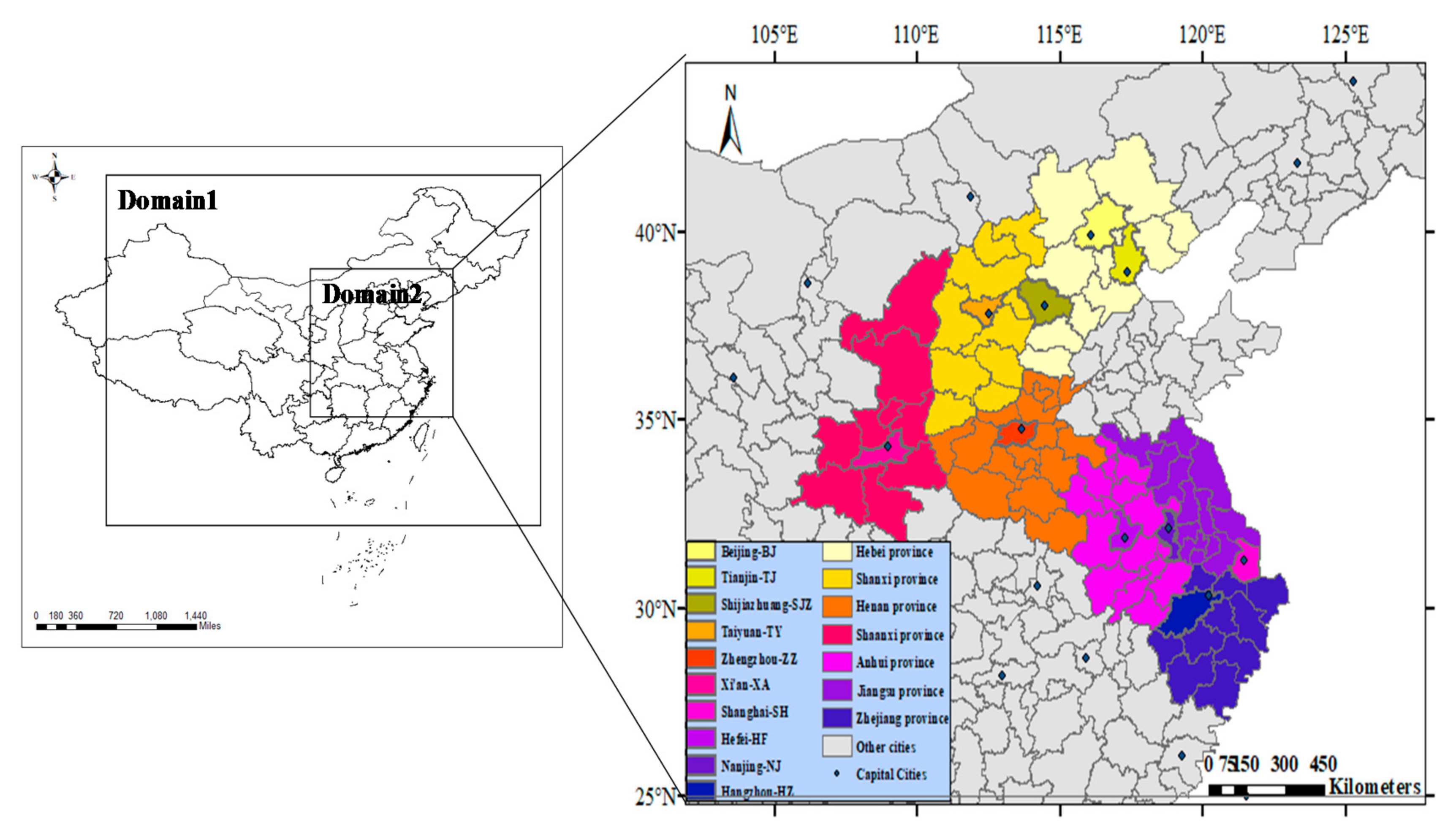
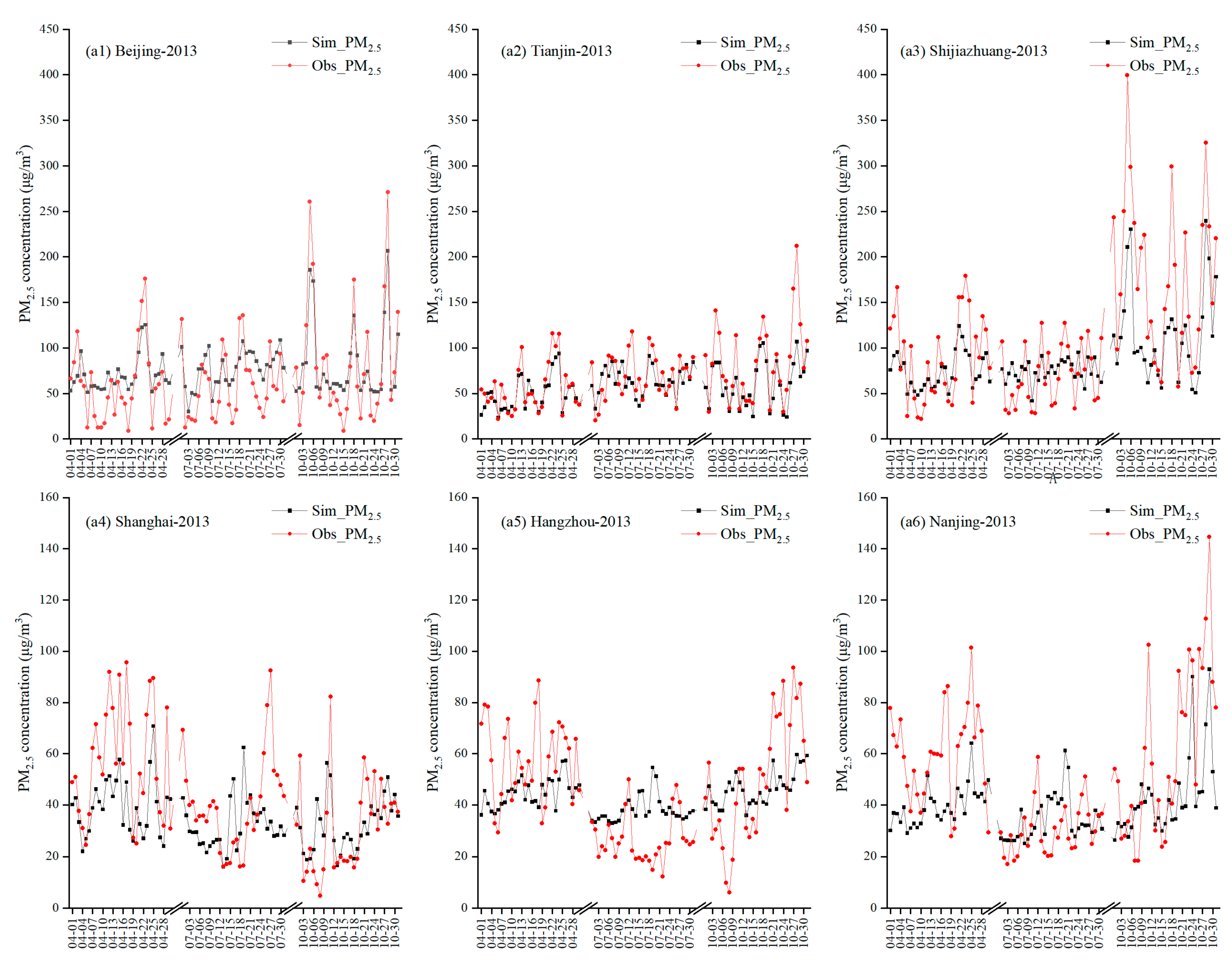
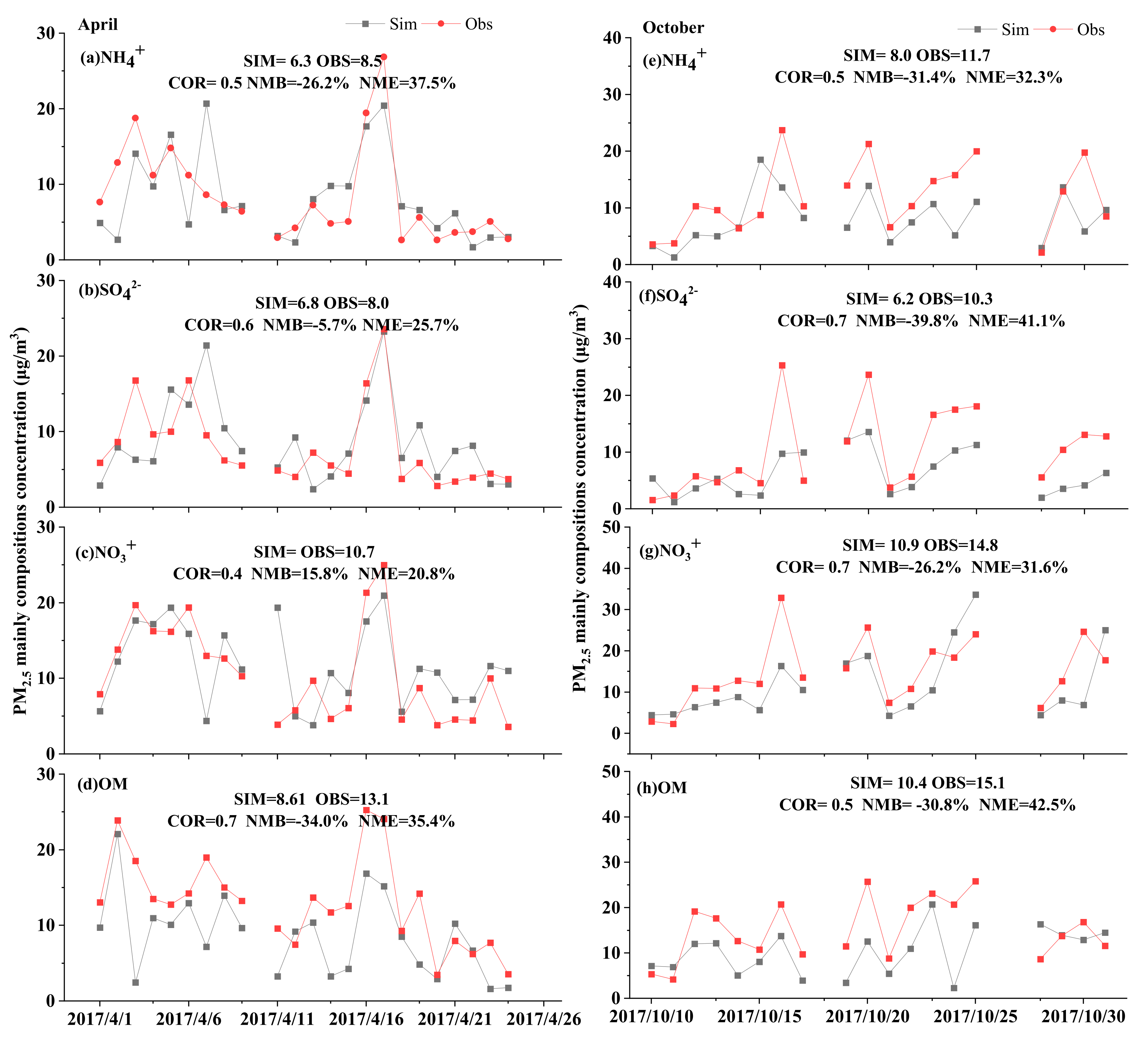


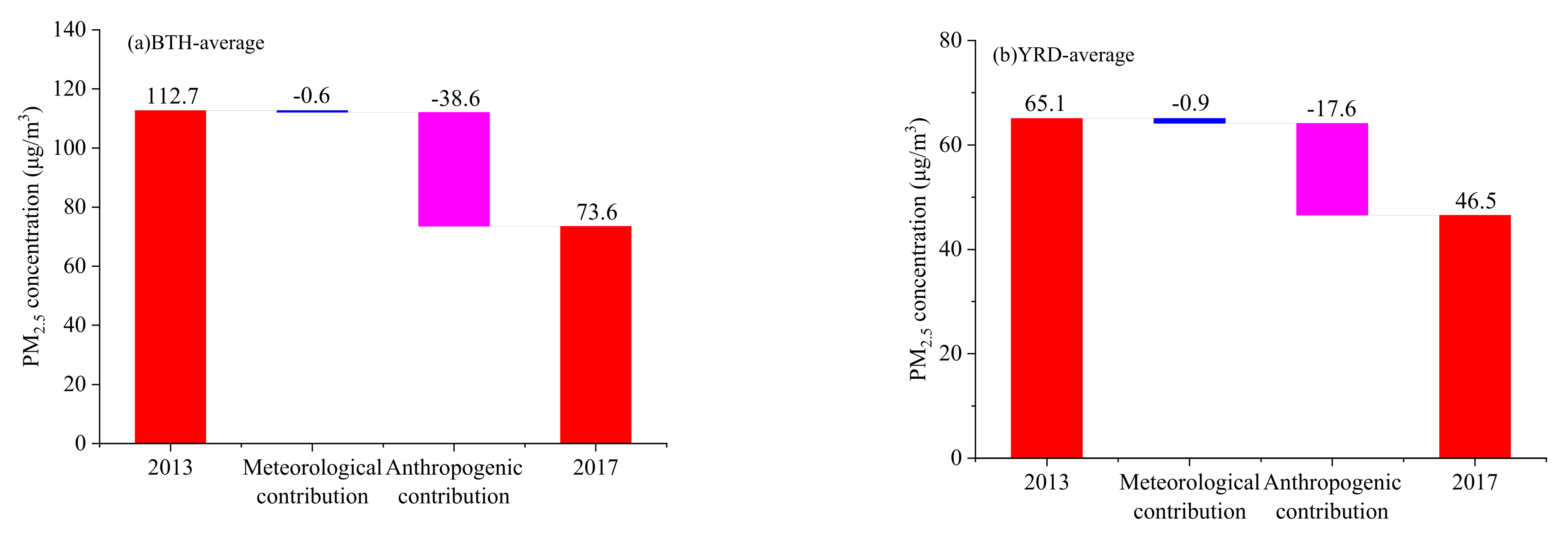
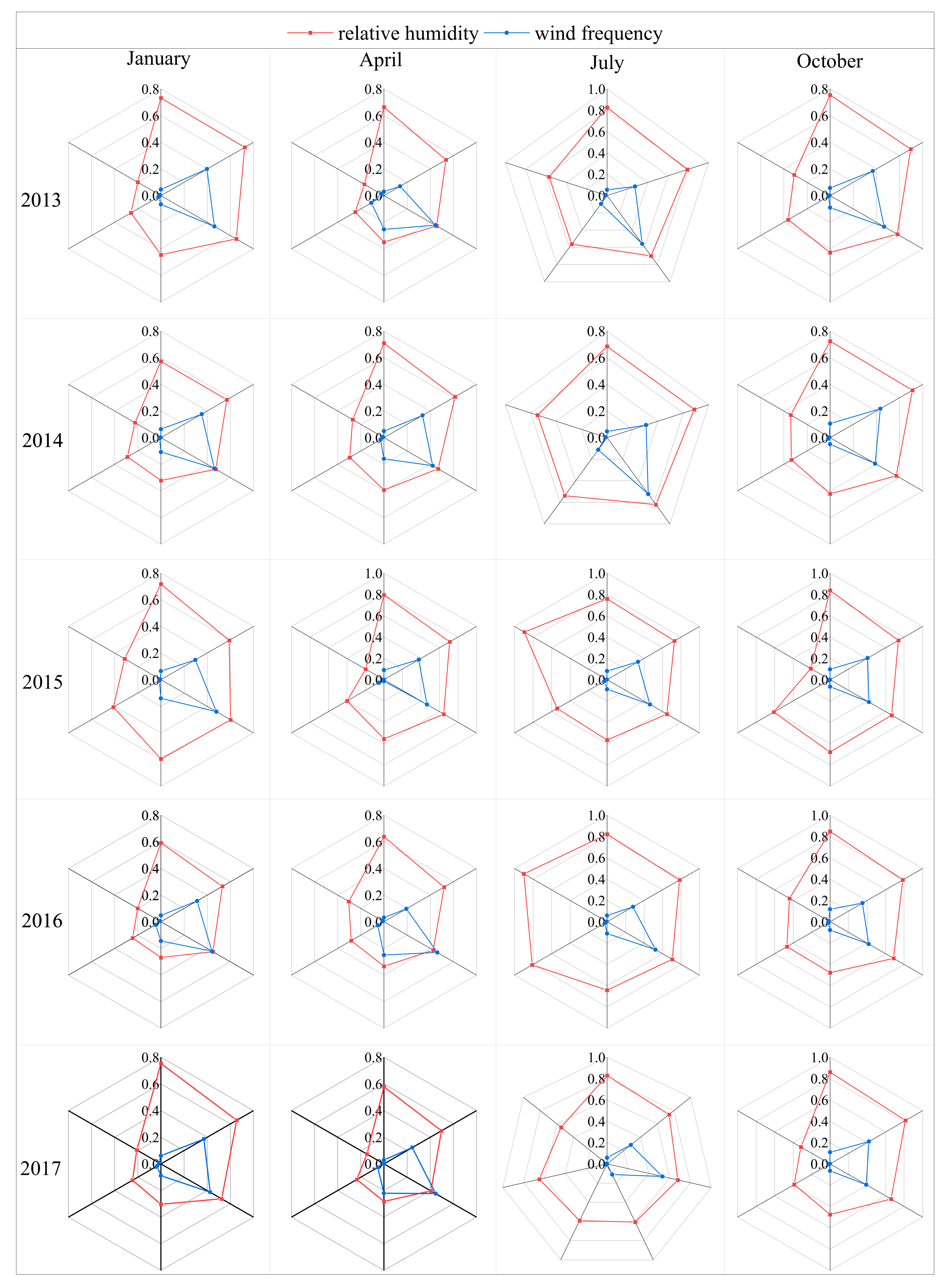
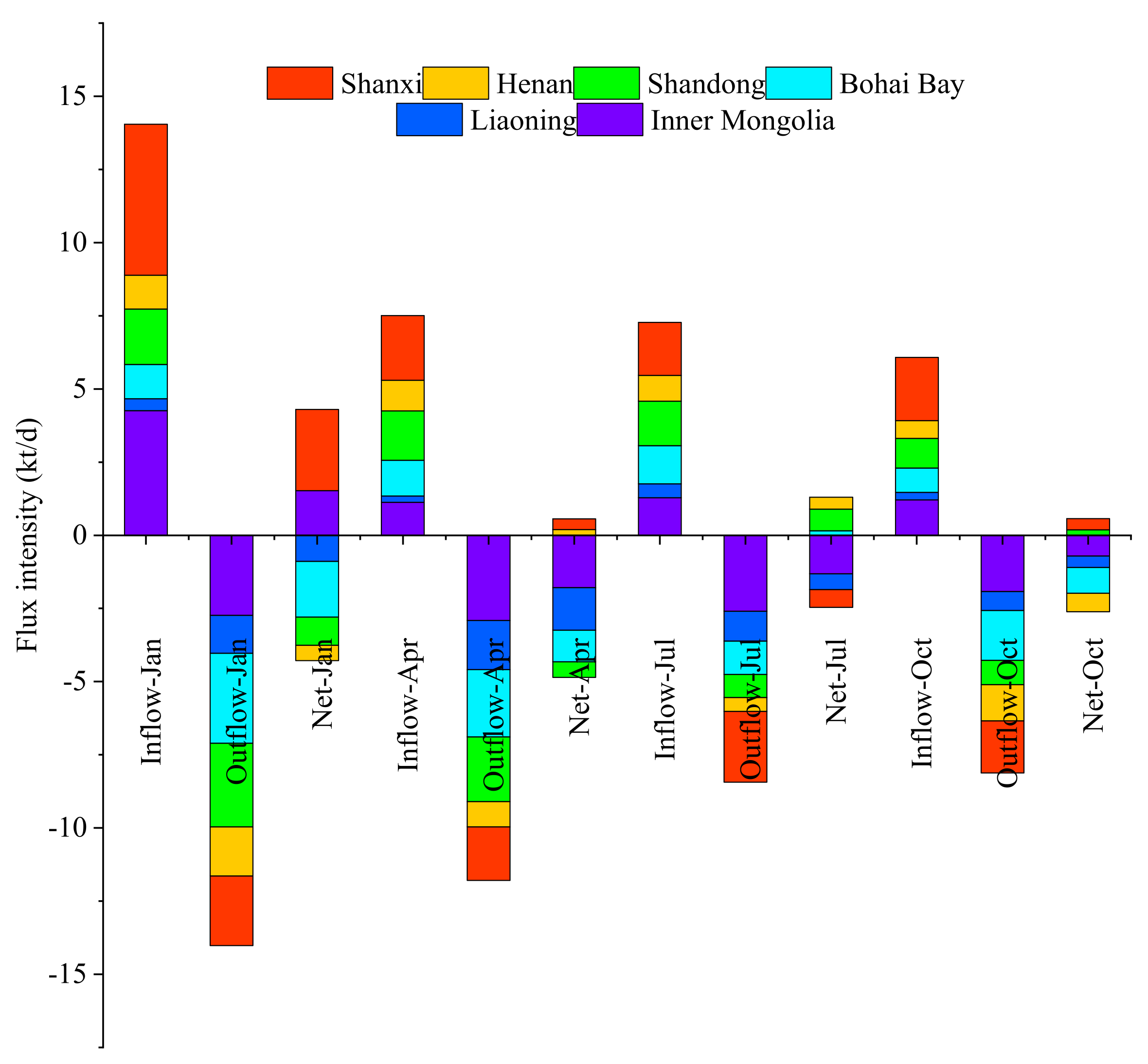
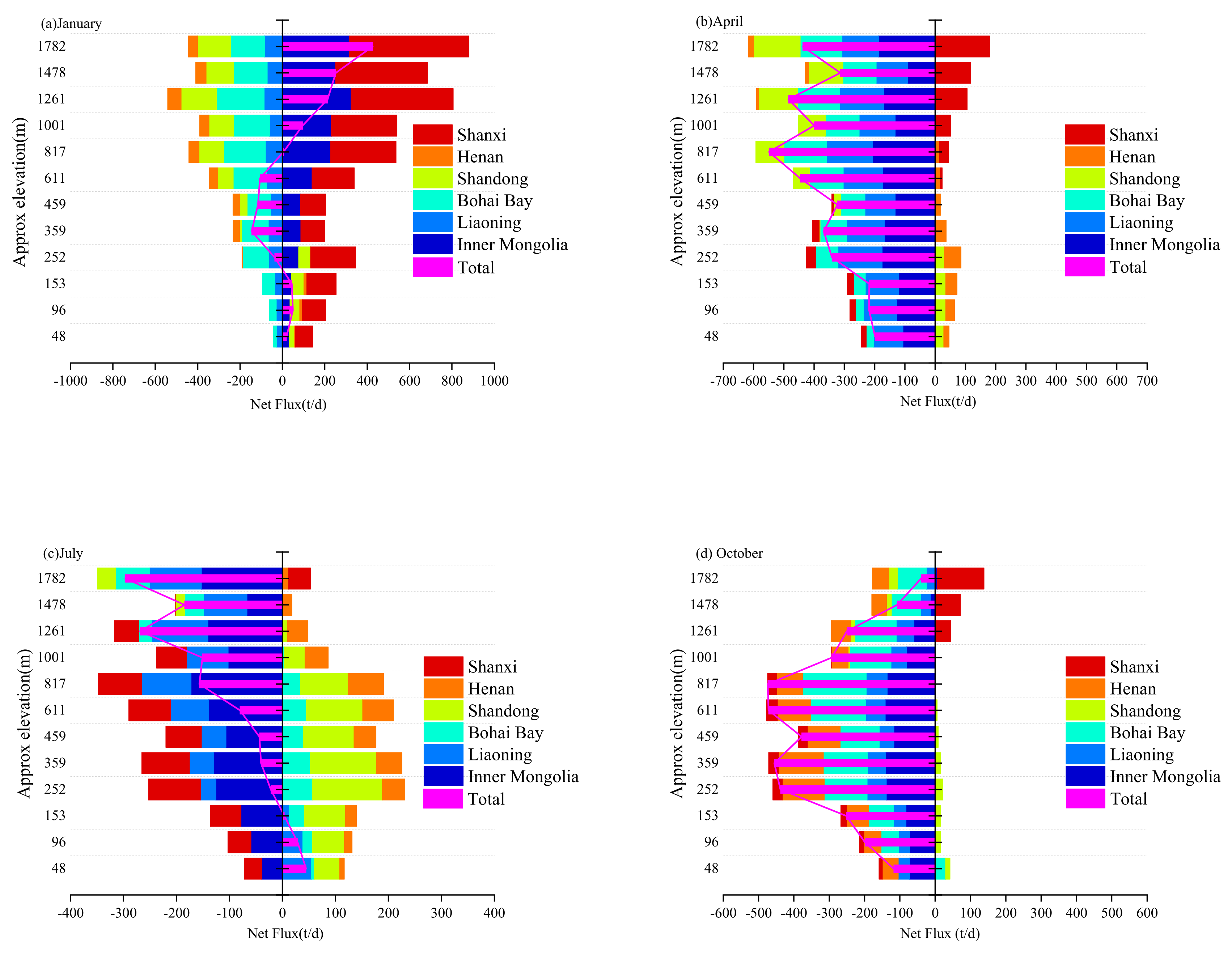
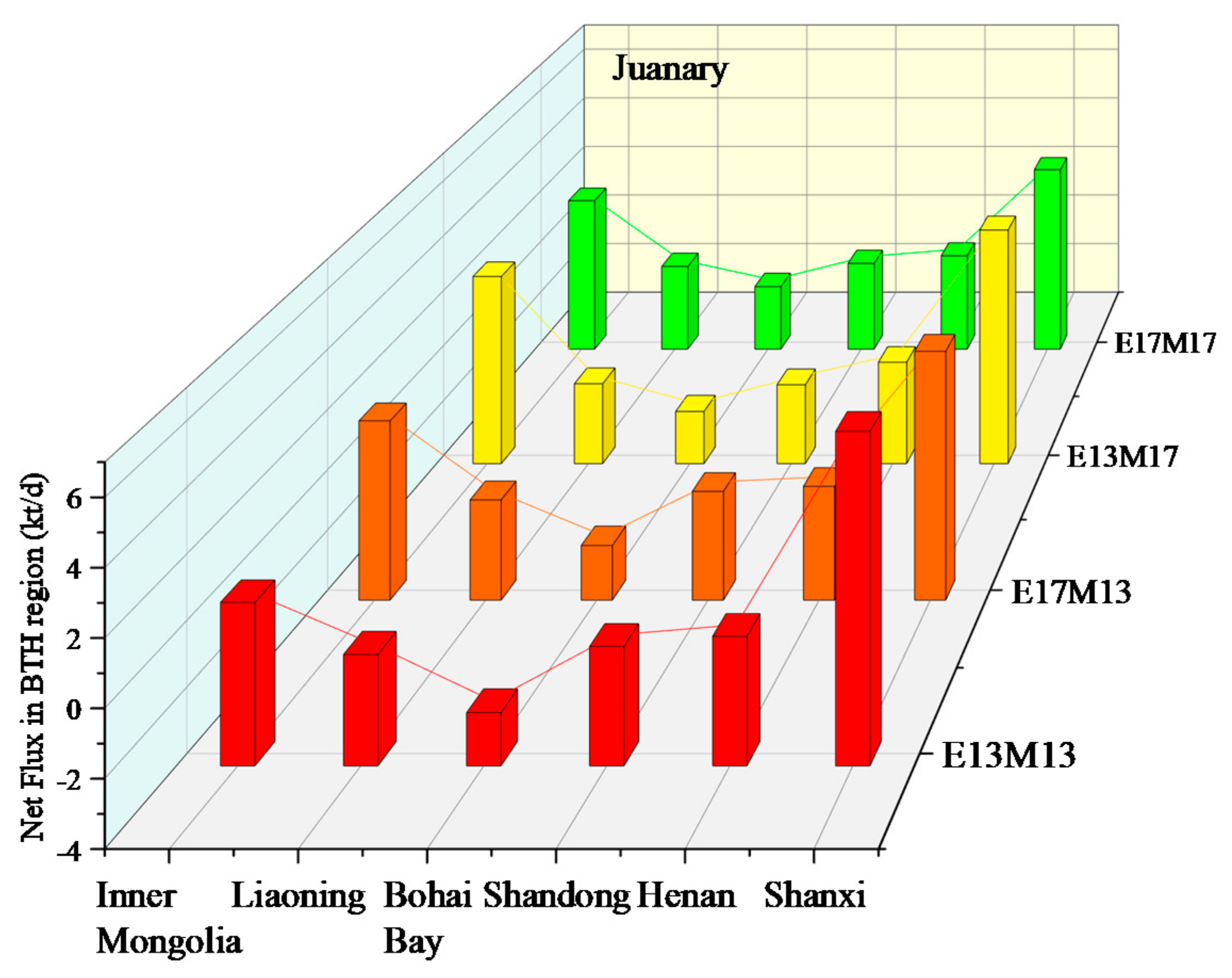
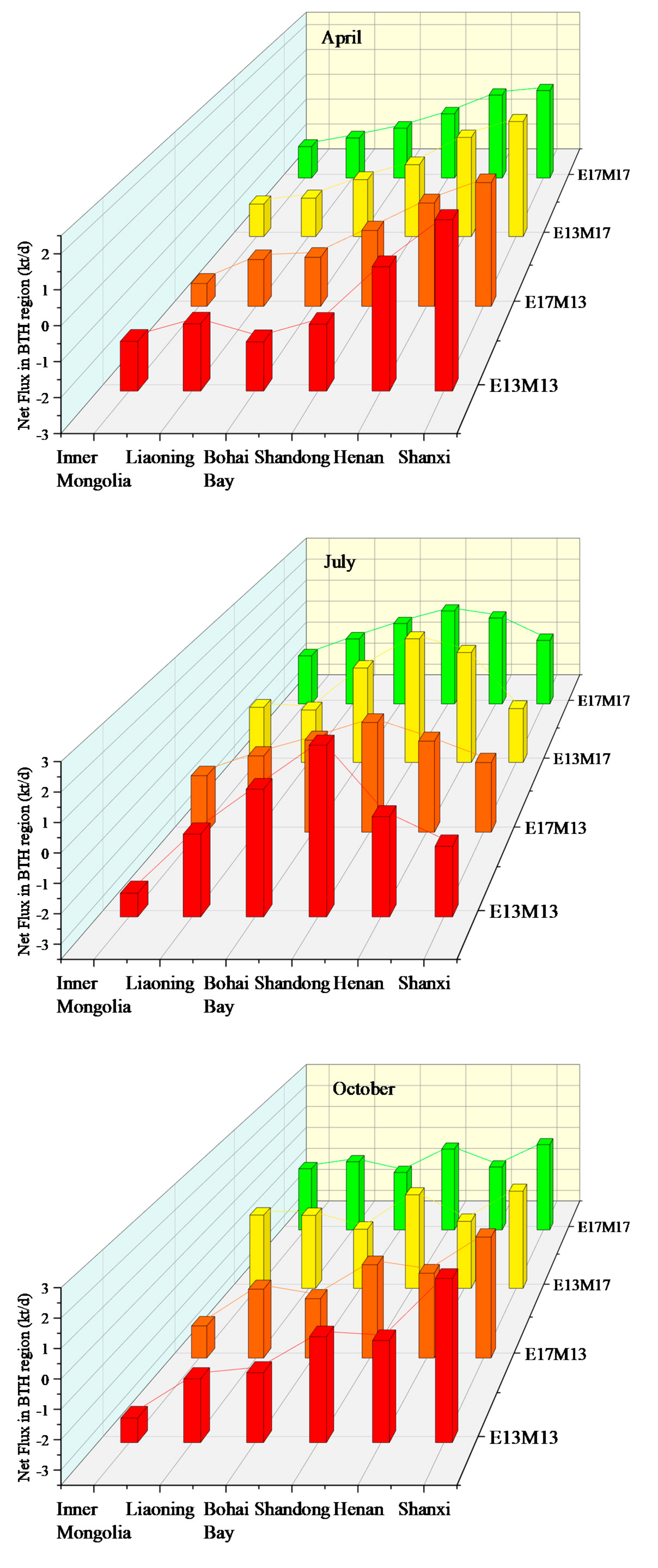

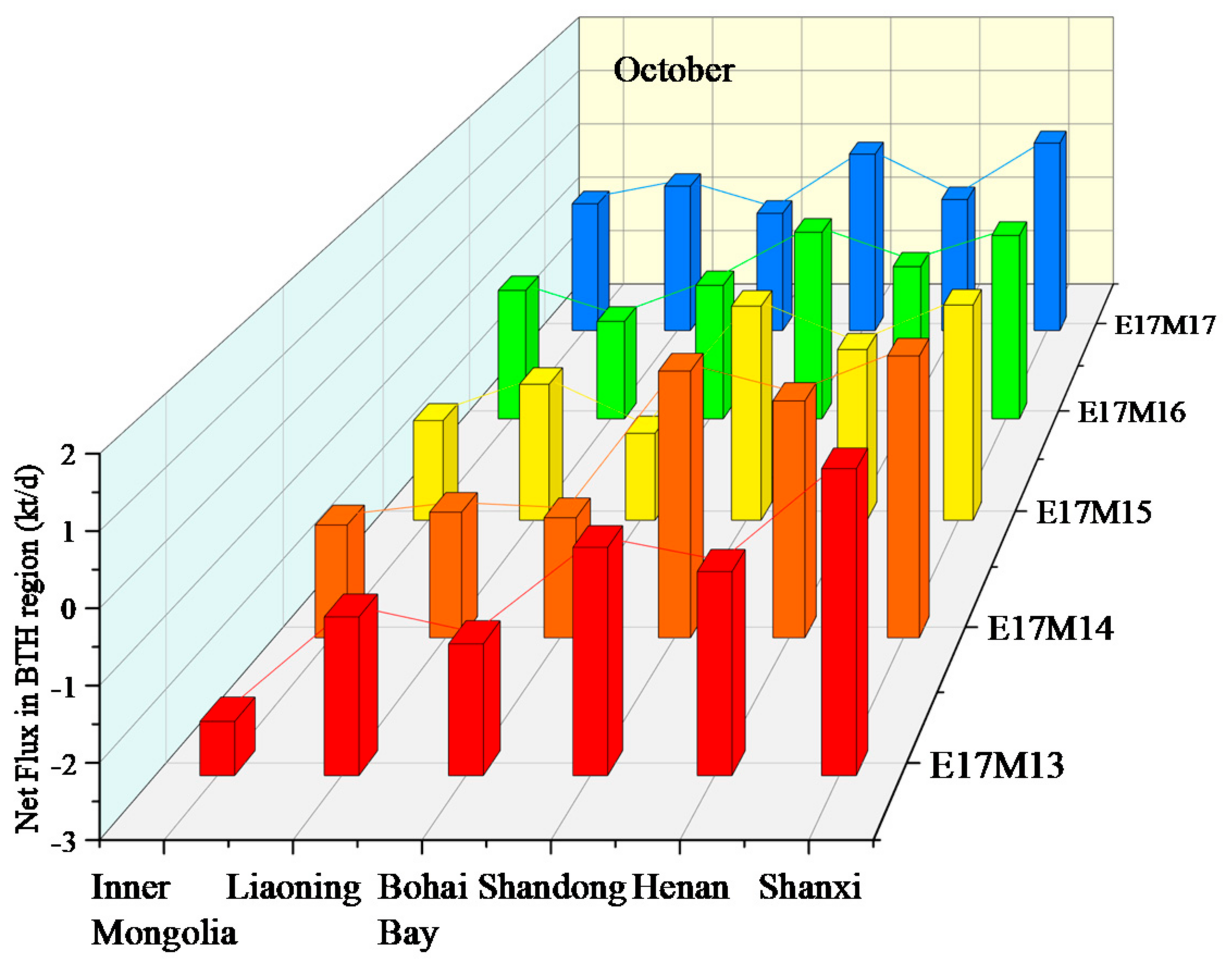
| Year | Regions | Cities | Mean_obs | Mean_sim | Corr | MB | ME | RMSE | NMB (%) | NME (%) |
|---|---|---|---|---|---|---|---|---|---|---|
| 2013 | BTH | BJ | 82.3 | 93.8 | 0.8 | 2.8 | 30.3 | 39.8 | 3.4% | 39.4% |
| TJ | 78.7 | 67.2 | 0.7 | −11.1 | 5.1 | 31.4 | −14.1% | 26.1% | ||
| SJZ | 117.6 | 94.9 | 0.6 | −21.9 | 75.4 | 53.3 | −18.6% | 34.8% | ||
| YRD | SH | 51.3 | 40.4 | 0.6 | −10.9 | 57.9 | 25.1 | −21.3% | 37.3% | |
| NJ | 60.1 | 44.5 | 0.7 | −15.6 | 32.4 | 27.6 | −26.0% | 36.2% | ||
| HZ | 54.1 | 47.9 | 0.5 | −6.1 | 36.9 | 22.4 | −11.3% | 33.6% | ||
| 2017 | BTH | BJ | 69.4 | 71.3 | 0.8 | 1.8 | 45.8 | 33.4 | 2.6% | 35.7% |
| TJ | 71.3 | 78.0 | 0.7 | 6.8 | 59.2 | 41.3 | 8.7% | 38.6% | ||
| SJZ | 99.5 | 83.9 | 0.8 | −15.6 | 35.0 | 45.9 | −18.6% | 40.7% | ||
| YRD | SH | 36.4 | 26.9 | 0.6 | −9.5 | 10.9 | 17.9 | −35.1% | 52.6% | |
| NJ | 37.4 | 34.7 | 0.8 | −2.7 | 43.8 | 20.3 | −7.6% | 44.6% | ||
| HZ | 42.2 | 40.8 | 0.8 | −1.3 | 53.0 | 20.2 | −3.2% | 36.3% |
| Study Regions | Case Label | Year of Meteorological Data | Year of Emission Data in Regions | Purpose of the Simulation |
|---|---|---|---|---|
| BTH | E13M13 | 2013 | 2013 | reproduce air quality in 2013 |
| E17M17 | 2017 | 2017 | reproduce air quality in 2017 | |
| E17M13–E17M17 | 2013–2017 | 2017 | quantify the impact of meteorology compared with 2013–2017 | |
| E17M17 | 2013, 2017 | 2017 | quantify the contribution from the emission reduction in local and surroundings during 2013–2017 | |
| YRD | E13M13 | 2013 | 2013 | reproduce air quality in 2013 |
| E17M17 | 2017 | 2017 | reproduce air quality in 2017 | |
| E17M13–E17M17 | 2013–2017 | 2017 | quantify the impact of meteorology compared with 2013–2017 | |
| E17M17 | 2013, 2017 | 2017 | quantify the contribution from the emission reduction in local and surroundings during 2013–2017 |
Publisher’s Note: MDPI stays neutral with regard to jurisdictional claims in published maps and institutional affiliations. |
© 2021 by the authors. Licensee MDPI, Basel, Switzerland. This article is an open access article distributed under the terms and conditions of the Creative Commons Attribution (CC BY) license (https://creativecommons.org/licenses/by/4.0/).
Share and Cite
Guan, P.; Zhang, H.; Zhang, Z.; Chen, H.; Bai, W.; Yao, S.; Li, Y. Assessment of Emission Reduction and Meteorological Change in PM2.5 and Transport Flux in Typical Cities Cluster during 2013–2017. Sustainability 2021, 13, 5685. https://doi.org/10.3390/su13105685
Guan P, Zhang H, Zhang Z, Chen H, Bai W, Yao S, Li Y. Assessment of Emission Reduction and Meteorological Change in PM2.5 and Transport Flux in Typical Cities Cluster during 2013–2017. Sustainability. 2021; 13(10):5685. https://doi.org/10.3390/su13105685
Chicago/Turabian StyleGuan, Panbo, Hanyu Zhang, Zhida Zhang, Haoyuan Chen, Weichao Bai, Shiyin Yao, and Yang Li. 2021. "Assessment of Emission Reduction and Meteorological Change in PM2.5 and Transport Flux in Typical Cities Cluster during 2013–2017" Sustainability 13, no. 10: 5685. https://doi.org/10.3390/su13105685
APA StyleGuan, P., Zhang, H., Zhang, Z., Chen, H., Bai, W., Yao, S., & Li, Y. (2021). Assessment of Emission Reduction and Meteorological Change in PM2.5 and Transport Flux in Typical Cities Cluster during 2013–2017. Sustainability, 13(10), 5685. https://doi.org/10.3390/su13105685





